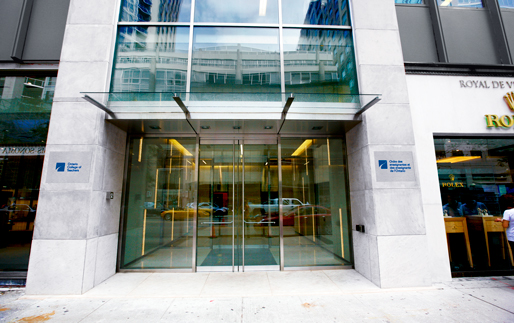Governing Ourselves informs members of legal and regulatory matters affecting the profession. This section provides updates on licensing and qualification requirements, notification of Council resolutions and reports from various Council committees, including reports on accreditation and discipline matters.
New building
Ownership of College’s new home benefits members
As the doors to the College’s new home open in the late fall, out go fears of fluctuating rents in a volatile commercial real estate market. College members – as owners – will have a hedge against rising future facility costs.
The march along Bloor Street from 121 Bloor Street East – the College’s one and only home for the past 13 years – to 101 Bloor Street West gives College members equity. The move also keeps the organization in the heart of Toronto, close to Queen’s Park and other education stakeholders.
With the lease on its current space due to expire in 2012, Council opted to buy facilities rather than rent.
The $28.7 million purchase price, including improvements, solidifies future College costs for housing. The existing lease on the College’s current space at 121 Bloor Street East expires in 2012 at which time the current rates are expected to double.
The purchase of eight floors at 101 Bloor Street West gives the College majority interest in the property located on Bloor at St. Thomas Street. This means the College will have naming rights to the building.
The location provides convenient access for members, applicants and College staff. It is steps from the Bloor-Yonge subway juncture, which draws commuters from all compass points in the Greater Toronto Area. The College receives more than 1,700 walk-in visitors a month now.
Although the College will command majority interest in the building, it will share the facility with other retail and government tenants. Commercial retailers have street-level frontage, while the Ministry of Children and Youth Services will occupy floors two through six.
Following the lead of teacher federations and other regulators who have opted to own their buildings, Council’s decision to buy was seen as the best option against future financial pressures.
The purchase will cost roughly $6 per member per year. Estimated costs to continue to lease, by comparison, ran between $6 and $8 per member per year.
The purchase of 81,000 square feet gives the College almost a third more room. The College also retains an option within the next five years to buy additional floors if required.
The College expects to pay the mortgage on the property within 25 years. This represents a savings of more than $6 million compared to estimated costs to lease similar space.
Honouring student artists
To ensure that Council and College staff always remember that students are at the centre of protecting the public interest in education, the new facility will have a dedicated wall adjacent to the Council chambers for student art.
Student canvases will be hung on the wall. Free-standing pieces will be housed in a special glass cabinet installed for that purpose.
Schools will be invited to submit a variety of student work. All will be returned at the end of the three-month presentation period. New installations will coincide with scheduled quarterly Council meetings.
To learn more about how to submit, contact Kathy McLaughlin, Office Co-ordinator, at kmclaughlin@oct.ca.
Going green
You’re doing it at home. You’re teaching it to students. “It” – preserving the environment – is education’s hottest topic and topical cause.
Preserving the environment is also at the heart of the College’s move to its new facilities.
“Energy efficiency is a key feature of the building and in keeping with our commitment to sustainable development,” says College Registrar and CEO Michael Salvatori, OCT.
We’re looking to make our new space smarter and greener. We want to consume less water and energy and reduce our operating costs. It makes good financial sense for our members, and it’s an example of what it means to be good corporate leaders and citizens.
Because we’re committed to the environment and to sustainable development, we’re seeking LEED (Leadership in Energy and Environmental Design) certification for commercial interiors.
We expect to reduce water use by 20 per cent by replacing washroom fixtures. We’re taking most of our existing furniture and equipment with us for reuse. Anything new will be Energy Star compliant. All workspaces, meeting rooms and major corridors will have recycling bins.
We will also provide space for staff to store the bicycles they ride to work and change rooms for them to use when they arrive.
As well, we’ve committed to diverting at least half of any construction waste from landfills.
Certain standards will be met for air quality and ventilation, energy use and cooling systems. Smoking will not be permitted within 7.6 metres of all entrances.
Windows in the entire building, constructed in 1970, have been replaced with energy-efficient, double-pane glass. The exterior was repainted shortly before the purchase closed.
As part of the deal, the current owners will restructure the 14th floor to accommodate Council chambers. As well, they will re-engineer the elevators to serve the entire building.
